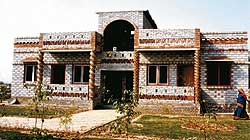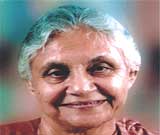In an effort to improve living and social conditions for the under-privileged, the Delhi Government has identified, among others, three chief areas to be addressed promptly. In all three areas, Pro-Poor projects are getting a look in.
First is the Sanjha Prayas (Universal Endeavour)—-a partnership between the Delhi Government and slum dwellers. It seeks to identify the travails and tribulations of the less-privileged and through a system of Bhagidari attempts to resolve issues.
Second is the Laadli Scheme aimed at empowering the girl child with financial assistance with the ultimate view to eliminate gender disparity among new-born children.
Finally comes the Government’s concerted efforts to make Delhi slum-free by significantly stepping up housing capacity with the aid of agencies like the Delhi State Industrial Development Corporation (DSIDC) and the Delhi Development Authority (DDA).
Although some may opine that the last is a populist measure before the Commonwealth Games 2010, there is no question that the step is very timely.
SANJHA PRAYAS
 Sanjha Prayas is essentially an offshoot of the Bhagidari initiative with the sole difference that it involves merely the slum dweller and not the more privileged. It is an initiative of the Delhi Government led ably by Chief Minister Sheila Dikshit and thousands of slum dwellers. Launched in 2007, CURE is consultant to the Bhagidari-Sanjha Prayas initiative. Sanjha Prayas is essentially an offshoot of the Bhagidari initiative with the sole difference that it involves merely the slum dweller and not the more privileged. It is an initiative of the Delhi Government led ably by Chief Minister Sheila Dikshit and thousands of slum dwellers. Launched in 2007, CURE is consultant to the Bhagidari-Sanjha Prayas initiative.
The poor living in slums and resettlement colonies are expected, under the scheme, to identify and prioritise problems and develop community level action plans through participative processes towards improving the quality of services in their settlements.
Another Governmental olive for the poor is easy loan facilities for constructing flats. What is more, these flats are supposed to be located in developed areas with schools, dispensaries, shops and playgrounds. Besides, JJ dwellers will be provided all amenities including transport so that they do not face difficulties and accept their new addresses as their permanent home.
LAADLI
The Laadli Scheme is significant, given its attempt to abolish prejudices against the girl child. Over the centuries, there has been heavy gender discrimination against female off-springs in several parts of India. The Delhi Government, therefore, launched the scheme which targets those parents who have only daughters and no son. Such daughters are eligible to receive an amount of Rs One Lakh at the age of 18, if registered at birth. Such a registration can also be done within one year of the girl’s birth with the Social Welfare Department of Delhi Government. Government then would open an account in a bank in the name of the girl child and deposit Rs 5,000 each at her birth, admission to class I, VI, IX and XII and passing of class X. This Rs 30,000 will accumulate interest to become Rs One Lakh when the girl child attains age of 18. Eligible to register are those families whose annual income is Rs One Lakh and who have been in Delhi at last 3 years.
HOUSING
Housing for the poor is another among CM Dikshit’s priorities. According to reports, the Delhi Government has committed to making itself slum-free, by constructing 50,000 flats by 2010. However, the fact remains that in June 2007 the Delhi Chief Minister assured jhuggi dwellers of Delhi of possessing respectful addresses in four-storeyed complexes with ownership rights. The Government, in fact, has shown the will and the mettle to live up to its promise, having inducted state-of-the-art technology to construct flats by the thousands in a span of six months.

"We have initiated several pro-poor projects and a scheme for the benefit of the girl child. These segments are critical to all round development of Delhi"
—Sheila
Dikshit,
Chief Minister, Delhi
The agencies involved in this daunting task are DSIDC and DDA. A DSIDC official says that under the leadership of CM Dikshit, it has already had the privilege of launching two schemes: Rajiv Gandhi Housing Scheme I and Rajiv Gandhi Housing Scheme II. Both are intended for industrial workers. The first one has been completed with 3,000 odd flats having been built in and around Bawana. The second, with around 4,000 flats in the inventory, is in progress at Narela and Bhorgarh. According to the DSIDC official, the project will be underway soon once administrative approvals are in place.
At a workshop (organised under Sanjha Prayas) the Chief Minister assured the jhuggi dwellers that the flats would be located in well-developed areas with schools, dispensaries, shops, playgrounds, and with the additional lure of easy loans.
The Delhi Government’s efforts are indeed laudable—it is not just looking to bring glitrz and glamour to the city, but also taking care to ensure that lives of the poor are lit up.
|